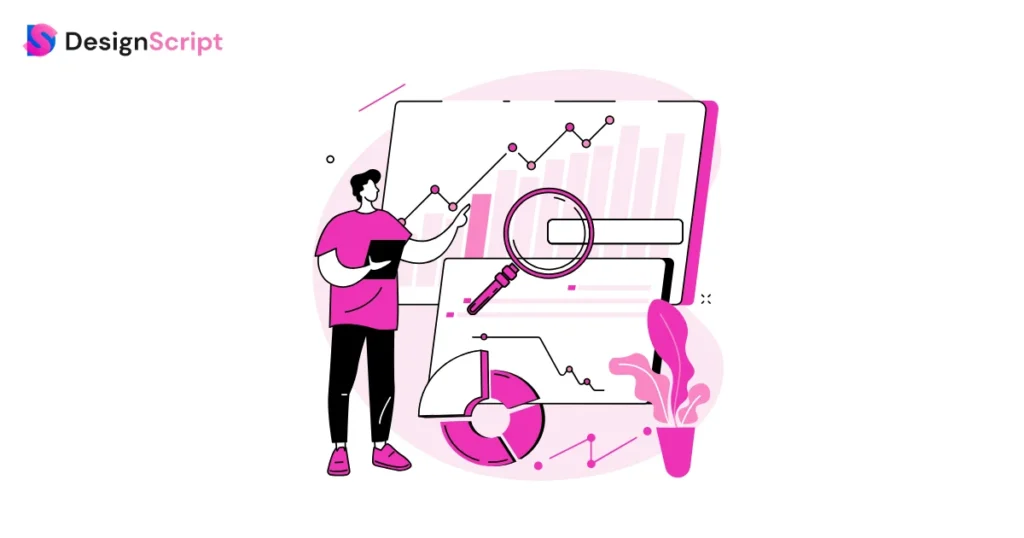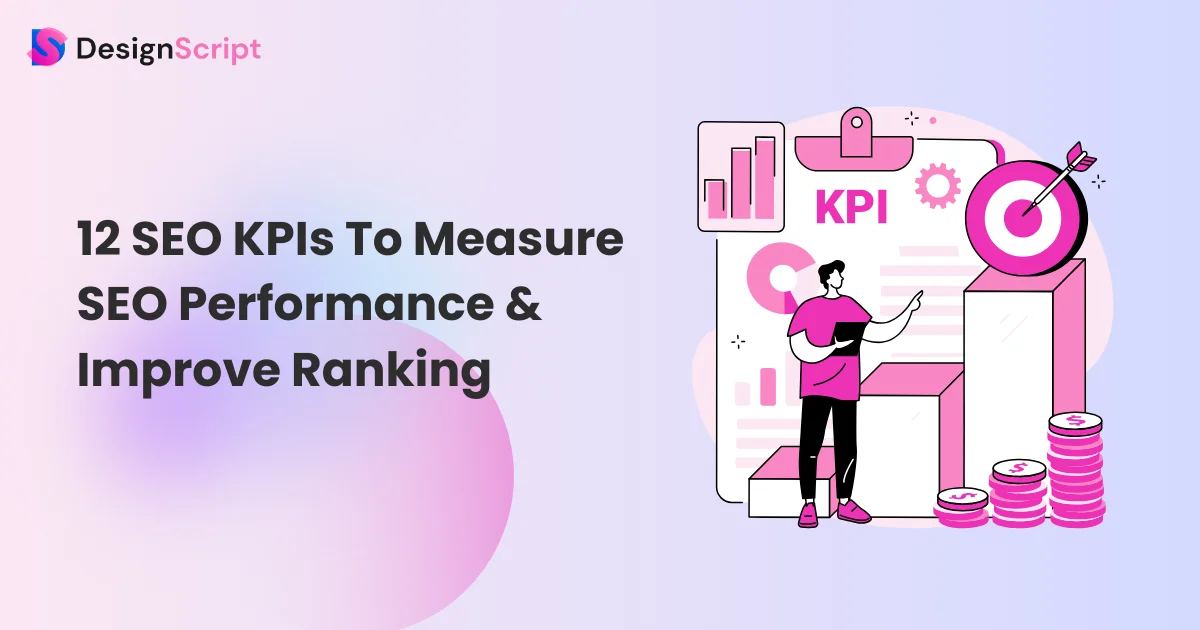12 SEO KPIs to Measure SEO Performance & Improve Ranking
Do you know that the top-most result in Google gets 32% of all clicks? That means you have to work towards ranking your website in the SERPs. For that, your SEO game has to be on point, or your efforts can run down the drain.
Needless to say, every marketer knows that SEO is essential, and you must regularly monitor your website’s performance. But what are the key performance indicators (KPIs) that really matter? That’s exactly what we’ll find out in this blog post.
So, without further ado, let’s get started.
Table of Content
What Is An SEO KPI?

SEO KPIs refer to metrics that are linked to search engine marketing. With the help of these metrics, you can know how your website ranks on search engines and the impact of your SEO efforts.
There are several different SEO KPIs, but the most common ones include organic traffic, search engine ranking, and conversion rate. By tracking these KPIs, you can better understand what is working and what needs improvement in your SEO campaigns. Setting and monitoring SEO KPIs ensures that your campaigns are on track and achieving desired results.
Why Is It Important To Properly Track SEO KPIs?

There are several reasons why it is essential to track SEO KPIs properly.
First, it allows you to see which SEO tactics are working and which ones are not. This is important because it will enable you to adjust your SEO strategy accordingly.
Second, it helps you to track your progress over time. This is important because it lets you see how your SEO efforts are paying off.
Finally, it helps you to identify any potential problems that may be affecting your SEO campaign. By tracking SEO KPI, you can ensure that your SEO campaign is on track and you are progressing towards your goals.
What Are The Best SEO Metrics To Track?

Here’s a list of the top 12 SEO KPIs you must monitor to understand the health of your blog in terms of SEO.

1. Customer Lifetime Value (CLV)
Customer Lifetime Value (CLV) is a metric that measures the total value of a customer throughout their relationship with a business. This includes the direct value of purchases made and the indirect value of things like brand loyalty and customer referrals.
CLV is a valuable metric for businesses. That is because it helps them understand how much they should spend on acquiring new customers and how much they should invest in retaining existing customers. CLV can also be used to inform marketing and product development decisions.
For example, if a business knows its CLV is high, it may be willing to invest more in marketing to reach new customers. On the other hand, if a business knows its CLV is low, it may focus more on developing new products or services that can increase customer lifetime value.
2. Organic traffic
The traffic that comes to your website without being paid for is called organic traffic. This could include traffic from search engines, social media, referral sites, and more. Organic traffic is an essential part of any SEO strategy, as it can help to increase your website’s visibility and improve your search engine rankings. While organic traffic is not the only factor affecting SEO, it is essential. If you’re looking to increase your organic traffic, you can do several things, including optimizing your website for search engines, creating compelling content, and building links.
3. Search rankings
Search rankings are one of the most important factors in SEO. They are basically a measure of how well a website appears in search engine results pages (SERPs), and they can have a huge impact on both traffic and conversions. Several factors can influence search rankings, including the quality of the website’s content, the number of inbound links, and the use of keywords. SEO experts try optimizing websites for all of these factors to improve their search rankings.
4. Search visibility
Search visibility is one of the most important metrics in SEO. It measures how often your website appears in Google search results and is a good indicator of your overall SEO performance. Several factors can affect your search visibility, such as content quality, the popularity of your website, and the strength of your backlink profile. It would be best if you focused on these key areas to improve your search visibility.
5. Domain authority
Domain authority (DA) is a metric used to determine the ranking of a website on search engines. It is based on several factors, including the website’s age, the number of backlinks, and the quality of the content. A website having a high domain authority will typically rank higher on search engines than a website having a low domain authority. Domain authority is not an absolute measure, and a website with a low DA can rank higher than a website with a high DA if the latter website has poor SEO. However, a website with a high domain authority is more likely to rank higher on search engines.
6. Links
Links signal to search engines that a website is popular and relevant, and they can help improve a website’s search engine ranking. There are two types of links: internal links, which connect one page on a website to another page on the same website, and external links, which link a website to another website. Both types of links are essential for SEO. Internal links help improve a website’s structure and make it easier for search engines to crawl and index the site. External links help to build the website’s reputation and authority.
7. Organic CTR
CTR is the ratio of clicks made on your webpage link to the total number of users who viewed the SERP. While a high CTR means high traffic, a low CTR tells search engines that the website is not up to the mark and doesn’t meet user expectations. This will lead to a low ranking. Therefore, you can’t afford to ignore this metric.
8. Branded traffic
Branded traffic is traffic that comes to your website from people who already know your brand, i.e. they search for terms that contain your brand’s name. The traffic could include people who have visited your website or seen your brand mentioned on another website or social media platform. Branded traffic is generally more valuable than non-branded traffic because these visitors are more likely to convert into customers or leads.
One way to increase branded traffic is to optimize your website for keywords related to your brand.
Another way to increase branded traffic is to create shareable content that promotes your brand. This could include blog posts, infographics, or videos that mention your brand. If you can get this content shared by influencers or popular websites, it can help to increase branded traffic to your website.
9. Bounce rate
Bounce rate is a metric used by Google to measure the percentage of visitors who leave your site after only viewing a single page. A high bounce rate is generally indicative of a problem with your website, such as poor content, a bad user experience, or a lack of relevant keywords. On the other hand, a low bounce rate indicates that visitors are finding what they’re looking for on your site and are engaged. While there is no magic number for bounce rate, a good rule of thumb is to aim for a rate below 50%.
10. Average session duration
The average session duration in SEO is the amount of time a person spends on your website during a single visit. This metric is important because it can give insights into how engaged your visitors are with your content. If you have a high average session duration, people spend more time on your site, which could indicate that they’re finding your content interesting and valuable.
On the other hand, a low average session duration could mean that people are leaving your site quickly, which could indicate that they’re unable to find what they’re looking for. Several factors can influence your average session duration, including the design of your website, the quality of your content, and the overall user experience. If you want to improve your average session duration, it’s important to focus on these factors.
11. Average Time on Page
This SEO metric defines the average time people spend on your page. While there is no definitive answer regarding what the ideal average time on page should be, a few factors can influence the metric.
First, the length of your content can impact how long people stay on your page. People will spend more time reading if you have longer, more in-depth articles.
Second, the design of your page can also affect how long people stay. If your page is easy to navigate and has a clean design, people will be more likely to stick around.
Finally, your audience can also influence your average time on page. If you’re targeting a general audience, they may spend less time on your page than someone specifically looking for the information you’re providing.
Ultimately, the best way to improve your average time on page is to create high-quality, engaging content that is easy to find and navigate.
12. Cost per click
Cost per click (CPC) is a pricing model in SEO where advertisers are charged based on the number of clicks their ads receive. The advertiser determines the cost per click, which can vary based on several factors, including the keywords targeted, the competition, and the advertiser’s budget. CPC is a popular pricing model because it allows advertisers to control their costs and allows them to scale their campaigns according to their budget.
Start Measuring Your Performance With The Top SEO KPIs
In this blog post, we saw the importance of tracking SEO KPIs and how you can use them to improve your SEO efforts. You now know how each metric is important, and it is worth investing time and effort in them. And you can understand where your website stands by closely monitoring each of them. You would know whether you are heading in the right direction, and it is possible to make course corrections if necessary. So, make Google search control and Google Analytics your new best friends.
So, start looking at your website’s SEO performance and identify which metric needs improvement.
FAQs

The 7 types of search engine optimization include Technical SEO, On-Page SEO, Content SEO, Off-Page SEO, Local SEO, Mobile SEO, and eCommerce SEO. By focusing on these, you can help improve your website’s performance.
You can use tools like Google search console and Google analytics to monitor SEO success. There are other tools as well, but these two are the most popular ones. By tracking vital metrics, you can improve your SEO.
There are several metrics to monitor for SEO, but the most important thing is to focus on the metrics that are relevant to you. You can track the organic traffic and conversion rate, domain authority, bounce rate, branded traffic & more.

